Adventures Afloat: Youth Set Sail on Lake Belton
By Stacy Moser | Photography by Chantz Cutts
Lake Belton Yacht Club Commodore Tex Mitchell and Cruise Director Michael Pilgrim are in the process of creating heroes.
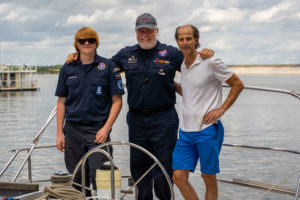
The two men volunteer, along with many other adults and parents, at the nonprofit Regional Sailing & Boating Center, part of the Lake Belton Yacht Club that’s based at Frank’s Marina. Their common goal is to promote sailing to the area’s youth by removing traditional barriers to the sport, like cost and access. The RSBC is home to a number of sailboats available for charter and is staffed by volunteers who teach sailing to local teens and Girl and Boy Scout groups.
As part of the training program aboard the fleet of boats, instructors emphasize safety education, which has had some fortunate side effects. “When I train young sailors about first aid out on the lake, how to take command of a tense situation, I prepare them to be a hero when they need to be,” Tex says.
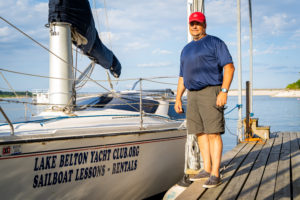
“But,” he continues, “I never expected them to be my hero. A few years back, I came out sailing with a group of kids, including my son, Tex Jr. I had a heart attack on the water during a race. The kids took over the vessel—these were 12- and 13-year-olds—they got me back to the dock and found medical care for me. In essence, by training them to do that, I saved my own life.”
Tex, who lives in Austin, is enthusiastic about the program and his involvement with it. “I spend 20 to 30 hours a week trying to promote the RSBC and keep it going, just because I love it so much.” He and Michael agree that their efforts to make the program fun keeps kids coming back for more. “But more than being fun, this program also puts young sailors in leadership situations, preparing them to be good citizens and future leaders. I’ve seen them become empowered to stand up for themselves, to make the right decisions and just be good people,” Tex says.
Michael’s path to service at the club was a circuitous one. In 2005, as a member of the Marine Corps Reserves, he was called up for a third deployment to Iraq and, as he describes it, “I spent a very tough year there.” In an effort to stay sane, he says he and some buddies daydreamed about owning boats once they returned stateside.
He fulfilled that dream not long after he came home. “I’m so glad I came to this club and took lessons,” he says. “The first couple of times I was by myself, I was scared I couldn’t get back to the dock. But once I learned how to do it, I just loved it. Anybody can drive a boat with a motor on the back of it. But when you’re sailing, you can feel the wind, get some speed—that quiet is just wonderful.” Michael’s burgeoning love for the sport then led him to volunteer with the youth sailing program.
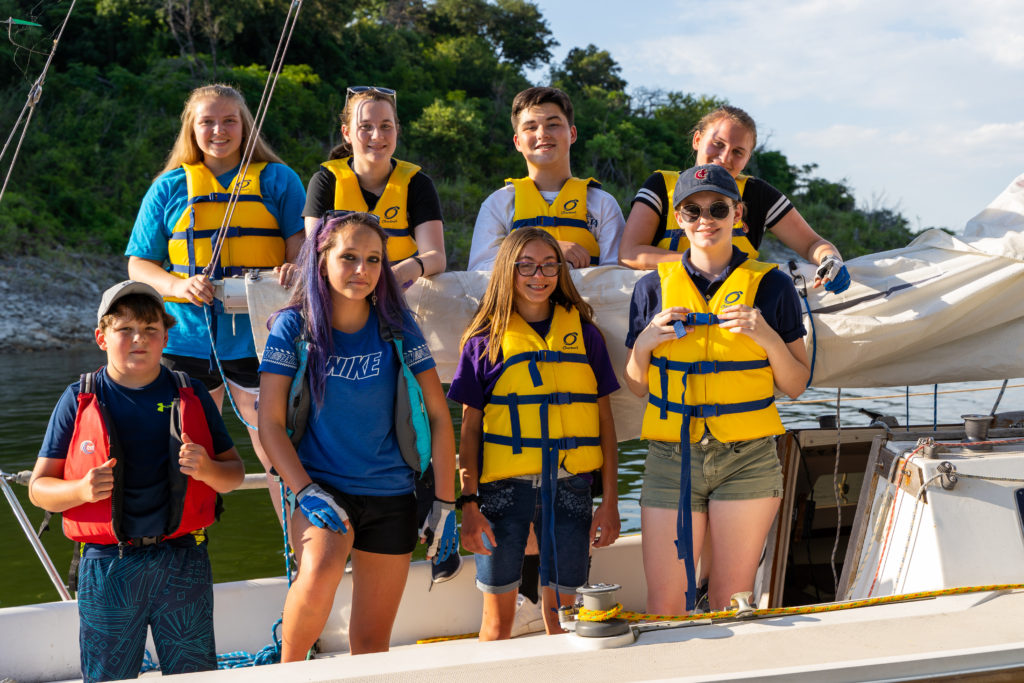
One of the club’s young sailors, Alexandria Severance, a freshman at Lehman High School in Kyle, recommends the sailing program to all her friends. “You’ve got to come out and try it,” she says. Another student in the program, Starla Whitlow, a sophomore at Lorena High School, came to the club for lessons through her Girl Scout Mariners sailing program. “The mariners have smaller boats,” she says. “But my friends and I wanted to get on bigger ones and learn more about them. So we joined this program and now I can sail any kind of boat.”
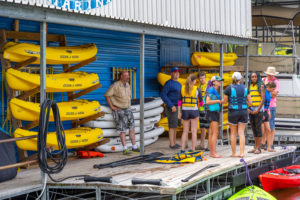 Jacob Hughes, a Scouts BSA troop scoutmaster and volunteer for the sailing program, explains that lessons kids learn on larger boats affect their ability to navigate everyday issues in their lives. “It’s like if you learn how to drive a bus, an 18-wheeler or a tractor—you’re not going to balk at driving any car you ever get into. These kids can hop onto any type of boat and do well. And they’ll be safe. I’ve never seen a leadership program like this. The students don’t just learn to sail, they learn how to maintain the boats; they’re responsible for them. They learn electrical systems and fire safety. They do man-overboard drills, use radios, navigate by the stars and read nautical charts.”
Jacob Hughes, a Scouts BSA troop scoutmaster and volunteer for the sailing program, explains that lessons kids learn on larger boats affect their ability to navigate everyday issues in their lives. “It’s like if you learn how to drive a bus, an 18-wheeler or a tractor—you’re not going to balk at driving any car you ever get into. These kids can hop onto any type of boat and do well. And they’ll be safe. I’ve never seen a leadership program like this. The students don’t just learn to sail, they learn how to maintain the boats; they’re responsible for them. They learn electrical systems and fire safety. They do man-overboard drills, use radios, navigate by the stars and read nautical charts.”
Kacy Lewis, also a sophomore at Lorena High School, sums up her experience on Lake Belton, “I definitely will sail for the rest of my life. I definitely will.”
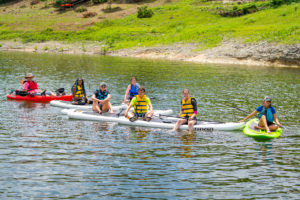 Michael, who is not only a Scouts BSA district commissioner, but works as a recruiter and Honor Society advisor at Temple College, knows a thing or two about how to motivate kids. He laughs as he describes talking to listless local teens he encounters. “I say, ‘Hey, you think the summer’s over? You think there’s nothing to do? No way! There’s a program out there that can get you out on the water—get sailing!”
Michael, who is not only a Scouts BSA district commissioner, but works as a recruiter and Honor Society advisor at Temple College, knows a thing or two about how to motivate kids. He laughs as he describes talking to listless local teens he encounters. “I say, ‘Hey, you think the summer’s over? You think there’s nothing to do? No way! There’s a program out there that can get you out on the water—get sailing!”
To find out more about their youth programs, go to LakeBeltonYachtClub.org.
When in Doubt, Wear It Out
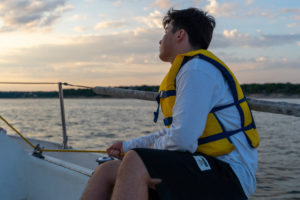 Nobody gets terribly excited about wearing a life jacket—let’s face it. But don’t overlook its importance when you’re out on the water. It’s the single most important water-safety tool available. Not all vests are created equal, though—check out these tips for choosing the right one.
Nobody gets terribly excited about wearing a life jacket—let’s face it. But don’t overlook its importance when you’re out on the water. It’s the single most important water-safety tool available. Not all vests are created equal, though—check out these tips for choosing the right one.
Comfort is key: If a life jacket isn’t easy to wear, you’ll be tempted to leave it in the trunk of the car. Many ultra-lightweight jackets are so comfortable, you’ll forget you’re even wearing one. Their mesh fabric allows air circulation and keeps you as cool as possible.
Wave your arms: Movement of your arms is essential when you’re on a boat. Look for jackets that allow the maximum range of motion for your arms.
Take the sit test: Try on a life jacket, then sit down in it. If the vest rises up and obstructs your face, that’s how it will fit when you’re in the water, too. Move on and find one that stays put over your chest when you’re seated.
Wet your whistle: Look for a jacket that has pockets for a whistle or light probe that can be accessed easily if you land in the water and want to call attention to yourself.
Appeal to the kids: If you trick out a life vest so it appeals to your kids, they’ll want to wear it. Let your little ones decorate their own vest by coloring it with markers.
See LifeJacketAdvisor.com
 The King of Knots
The King of Knots
One of the most useful skills in a sailor’s toolkit is the ability to tie a strong knot. Rookies are usually taught to tie a Bowline Knot (pronounced “boe-lin”), sometimes referred to as the King of Knots because of its importance in the world of boating. The knot is extremely strong, but can be untied easily, even if it’s been under a lot of strain.
Next time you pile your grandma’s couch into the back of a truck—use a bowline knot to keep it from launching out of the truck bed as you rocket down the highway. For knot-tying tutorials, visit AnimatedKnots.com.



